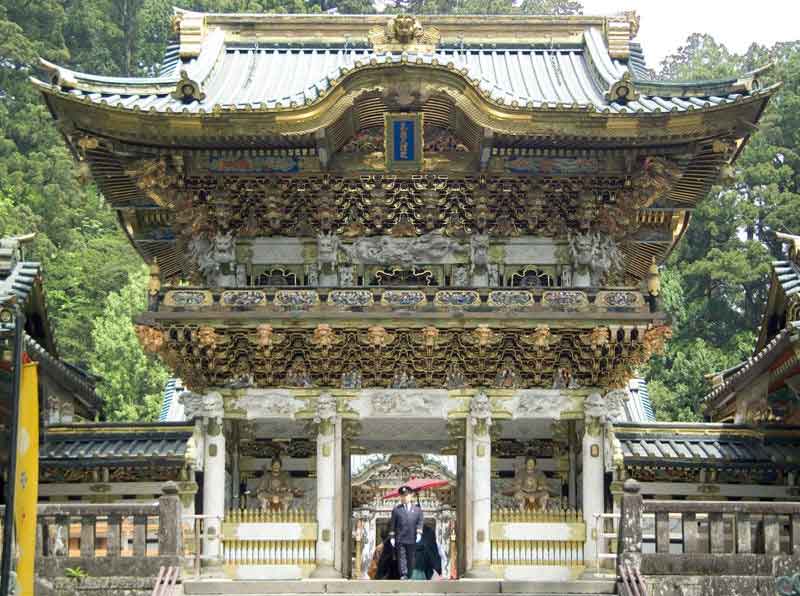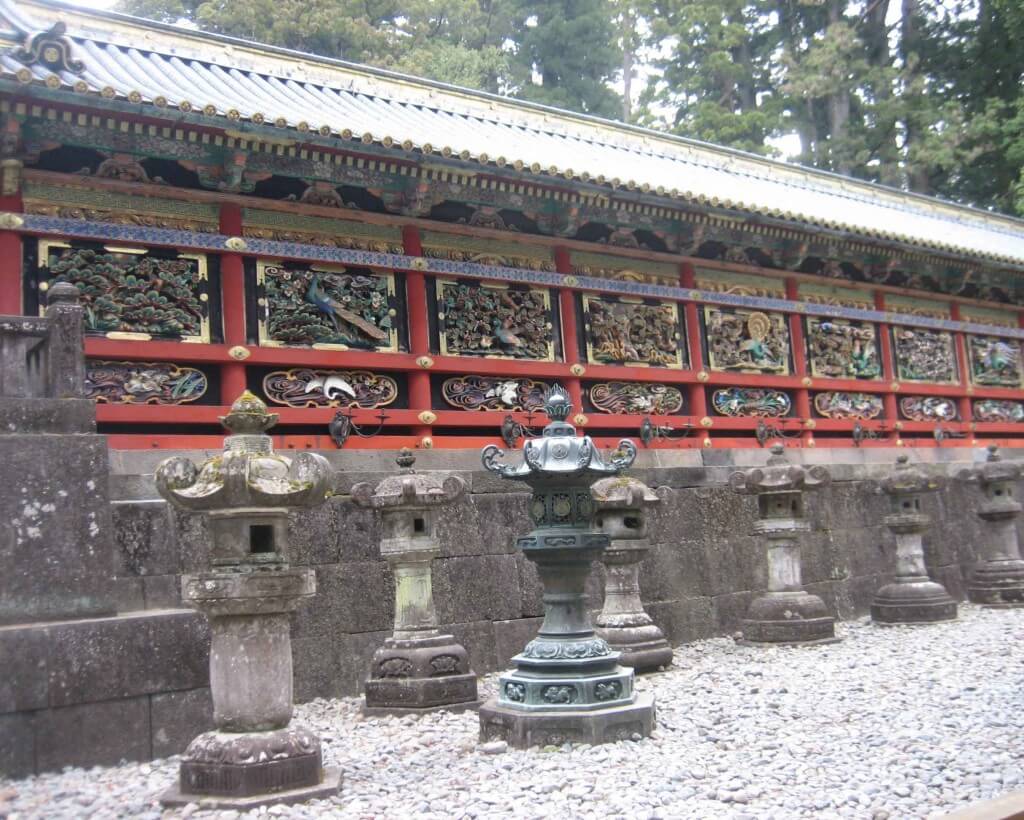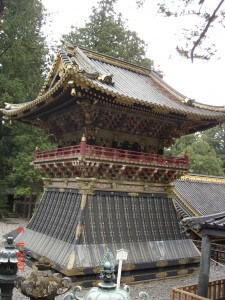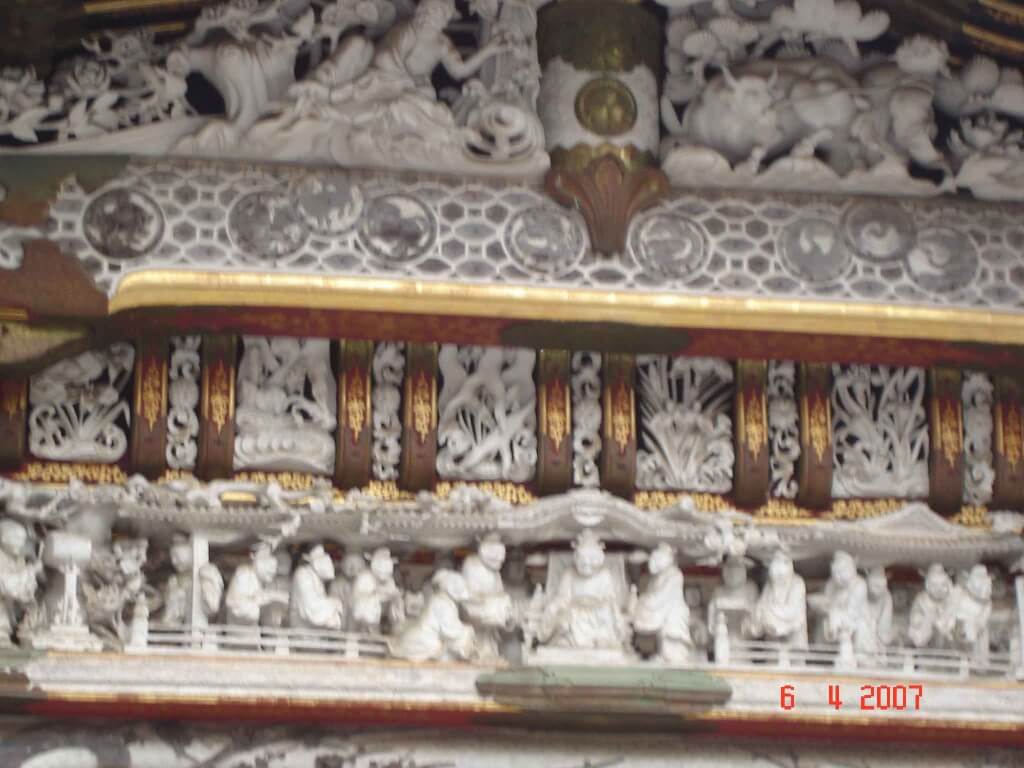Yomeimon gate
The Yomeimon Gate (a National Treasure), is breathtakingly beautiful; the exquisite sculptural decoration is amazing in its color, detail and different techniques. It has over 508 sculptures. Of these 194 are imaginary animals, called Reiju (Holy, or spiritual animals). Truly a wonderful monument to the artistic skill of the craftsmen.
The Yomeimon (Sunlight Gate, so called because it faces south) is named after one of the twelve gates of the imperial court in Kyoto. It is also popularly called “Higurashi-no-mon” (Twilight Gate) because it is believed a person can stand from dawn to dusk looking at all its sculptures and beauty.
Built in 1636, Yomeimon Gate is 11.1 meters high, 7 meters wide, and 4.4 meters deep. It has twelve pillars colored in white pigment and carved with scrolling patterns.
Despite its appearance of perfection, Yomeimon Gate is not perfect. It has a famous pillar called Mayokeno-sakabashira (Inverted pillar for amulet). This inverted pillar was so placed in order to avoid angering the gods with a presumption of perfection, as only the gods acquire perfection. It is located on the left side of the Yomeimon gate and was deliberately placed upside down. A fact not so well known, is that there are two more inverted pillars in the Honden and the Haiden.
Tozai Kairo
The wall flanking the Yomeimon Gate also features wonderful detailed sculptures. It is known as the Tozai Kairo and is actually a roofed corridor. Constructed in 1636, the inside and outside are decorated with 320 sculptures of flowers, birds and animals.
Nearby is the Bell Tower (Shoro) placed on the eastern approach to Yomeimon Gate and the Drum Towers (Koro) is opposite. They are relatively the same in size but it is said the decorations on Shoro (Bell Tower) are more gorgeous than on Koro (Drum Tower). There are 78 carvings of cranes, dragons and waves, very colorful and detailed.
Kaguraden is located on the right side of the Yomeimon Gate. It is a hall where kagura (or sacred music and dances dedicated to gods) is performed by shrine maidens. The front part of this building is a stage for dancing, and the back part for backstage.
The Kamaron
THEN there is the Karamon (or Chinese style) Gate, (also a National Treasure). It is a four-gabled edifice painted in black and white. A Chinese technique of inlay work is applied to the sculptures; images of Chinese sages are engraved in relief on the transom; very different but very beautiful.
It is the gate leading to the Honden main hall of worship. Both the front and back gate were constructed in 1636. The Shomen Karamon or front gate, is 3m wide and 2m deep and decorated with some 600 exquisite sculptures.
The Kamishamusho Hall is where the chief Buddhist priest would pray for world peace in the Edo period. It is located near the Kaguraden hall. Previously it was known as Goma-do and now it is called Kitou-den. Formerly it was used for ritual ceremonies, now wedding ceremonies are held in the hall. It is beautifully decorated with basic colors of black, gold and vermilion.
Shinyosha – Shed of Portable Shrine is a quiet building by comparison and holds three portable shrines, which are considered to be sacred sedan chairs. Each chair weighs 800 kg and needs fifty five people to carry it. On the ceiling of this hall are paintings of beautiful angels dancing and playing music in heaven.
The Honji-do Temple “crying dragon”. This dragon is painted on the ceiling of the temple. It makes a sound like roaring when clappers are struck standing underneath the dragon.
The interior of this temple is rich in color,gilded decoration and exquisite sculptures, and Buddha’s. The Twelve Gods of war are enshrined on both sides of Yakushinyorai (Yakushi Buddha). They have twelve different kinds of animals on their heads which are symbols to protect man from misfortune or disaster.
The chancel of the Honji-do Temple enshrines the Yakushi Buddha, or Physician of Souls. The Yakushi Buddha is the principal object of worship in the Temple. On either side of the Yakushi Buddha stand the Sunlight and Moonlight Buddha’s. The Temple is built in authentic Buddhist temple architecture.
There were various other temples to see here, just not enough time to see them all and take it all in. I enjoyed every minute of this experience, feasting on the beauty, aesthetics and architecture at the Toshogu Shrine. See my pics.
Wow! What can one say about Nikko and the Toshogu Shrine? it is an amazing and wondrous Shrine of beauty. Japanese culture is such a different experience. I could have spent the whole day here. As it was, we had to move on.
If you visit Japan this is only a couple of hours drive from Tokyo, or you can book a bus tour, or travel by train from Tokyo.
Nikko and The Toshogu Shrine is something not to be missed.
Do read up on Nikko and the Toshogu Shrine before you come . You will have a much better idea about what you are seeing when you get there, and make it easier to absorb and enjoy its beauty.
One of the best travel books I have found is the DK Eyewitness Travel Guides
on any country. It is very informative with the history of each area of a country, detailed maps, the architecture, religion and photographs with detailed knowledge of all the most important cultural centres, monuments,Temples etc.,.
I was also able to buy a booklet at the shrine, entitled ‘National Park Nikko’ which has wonderful photo’s of all the buildings in the Toshogu Shrine including Yomeimon Gate and the interior of the Honji-do temple. It is inexpensive, and is a splendid record to have of this magnificent complex at Nikko.
Next, Lake Chuzenji and Kegon Waterfall last on our list for the day before returning to Tokyo .
Photo’s: Toshogu Shrine Tokyo Japan




Truly beautiful. I can`t believe the exquisite sculptural decoration and the fine detail. I will have to see it for myself during my next visit to Japan.
Hi John, The Toshogu Shrine is a “must see” on your next trip to Japan, and there are plenty of tours out of Tokyo to take you there, so don’t miss it next time. I also went to Hiroshima on my trip, which I found a very moving experience. Thnx for your comments. Lyn
It’s a really popular shrine. I think I might have read about this from a magazine or a newspaper somewhere, it said that it took about 15000 worker to get the structure done in 2 years and used over 2 million sheet of gold leaf that was placed in and around the shrine.
The Japanese are known for their attention to details and this was no different. A really beautiful shrine!
Hi Mitch, The Toshogu Shrine is very gold and gleaming in the sunlight, the sculptural decoration and detail is quite amazing. Guess that is why they say a person can stand and look at it all day. Japan is a lovely country to visit. Thanks for your comment.
Thanks for sharing your thoughts on Japan tokyo Travel.
Regards
Your welcome. thanks.